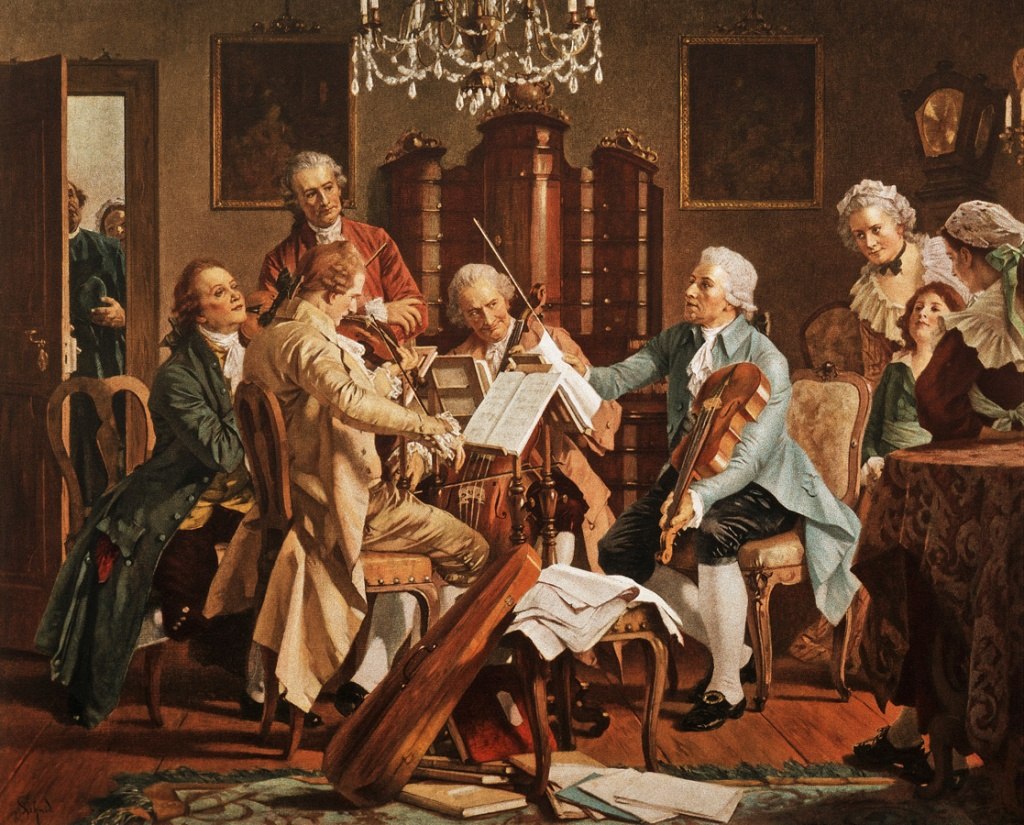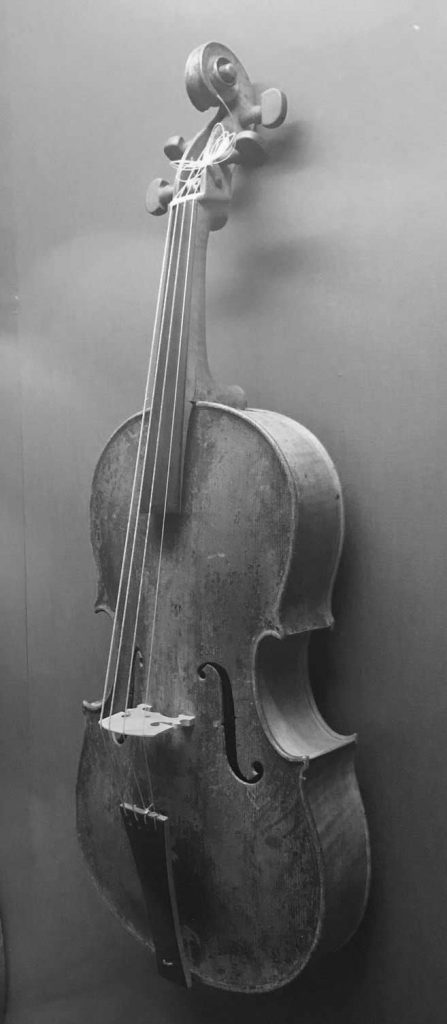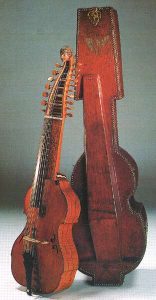
This painting in the collection of the StaatsMuseum in Vienna depicting Joseph Haydn conducting a string quartet would seem to present a unique conundrum within the history of the viola. The rib depth, corpus length, and vibrating string length are synonymous with a completely unique current of instrument making in Southern Germany and the Northern Alpine region.
If you look closer, however, there is almost a dream-like cast of emotion, as if plucking out the image from a Phantasie or dream. The expressions all are unique, and in a kind of unison of conflicting emotions, seem each to tell some knowable story in time. This aspect is uncharacteristic, or if so, extremely rare in 18th Century paintings. In fact, things all seem executed in a suspiciously Biedermayer style of painting. If you have been fooled by the image in the past, rest assured, you are not alone. The image is currently cataloged as before 1790 with Wikipedia. It has been used countlessly as a reference image, as album artwork, and on several websites which seem to accept the painting as contempary to Haydn. If the image were an actual, faithful depiction of a chamber rehearsal in Schloss Esterhazy, it would present a rather bizarre contradiction with the use of tenor viola in a quartet setting. Sadly, for our illustrative purpose the painting was done in the 19th, or even early 20th Century, and has managed to float through time, evading reason, caputuring the imagination, for better or worse.
This image is currently cataloged as Kriegsverlust. STOLEN During the Second World War.
Let us for a moment assume that the image depicted an actual instrument. I ask this flight of fantasy for the implications it might have, again, purely for speculative purposes. The specific coincidence of the instrument depicted having rib depths similar to those rare surviving tenors is something rather remarkable, if perhaps implausible.
Tenors of this size were quite common within Italian, Flemish, German, and other schools of lutherie; Antonio Stradivari, Andrea Guarneri, Gaspar da Salo all produced large tenor violas with comparable corpus lengths of 45cm and larger. What is different here is the uncommon rib depth, and rather logngish neck, which would have resulted in a a longer vibrating string length and substantially large amount of air volume. The timbre of these unique instruments are quite different from your standard, 43cm large viola and should, from an organological perspective, almost be separated entirely.
These instruments were likely played as depicted above; the weight of the viola is cradled along the arm, and may or may not have been supported under the chin. Johann Michael Alban (1677-1730) the second born son of Matthias Alban, produced a very similar instrument to the viola depicted above. Made in 1707, the rib depth of 56mm appears to be nearly identical to Haydn’s instrument. Miraculously, it has survived mostly intact, with even original varnish.

The 1707 Aban Tenor viola.
Would it make any sense then in our imaginary dream that Haydn had chosen a tenor viola within the context of a quartet setting? It is complelty incongruous to our contemporary concept of middle voices; a kind of White Whale, far removed from our normal interpretations of the middle, alto register. While I would hardly wish to put forth the argument that large tenors should be employed in a quartet setting, one also must consider that the contemporary genre of the string quartet was essentially established by Haydn in the 1750s, and this is something of a miracle, considering that until 1779, his life was comparable to that of an indentured servant, in the service of Prinz Nikolaus Esterhazy.
The Tenor Viola as congruent parter to Baryton and Violoncello in the Divertimenti.
Haydn had as contemporary the musicologist and theorist Johann Mattheson and must have been familiar with his treatise of 1713, Das Neueröffnette Orchestra, in which he unequivocally urged the separation of alto and tenor violas into two parts, Viola Prima and Viola Secunda . One may note his use of bold face typography on the German word Notwendig (using the archaic spelling) but also that he stresses it is the most important element (Nothwendigsten) in a harmonious concert. 
It would thus seem perfectly natural that a tenor was needed when composing the trio sonatas and Divertimenti, which employed viola and the relative bass/tenor range, and that Haydn may have been keenly aware that the alto size viola, which commonly had a corpus of as small as 38cm, would not be tonally congruent with longer string length instruments. Furthermore, the uniquely different tenors being produced in Germany and Austria with vastly deeper rib structures than the common tenor would have delivered sufficient depth of tone to match the timbre of the other two parts. So in essence, this would make much more sense to employ a tenor viola instead of a tiny, 39cm corpus alto instrument.
The period after 1779 marked the renegotiation of Hadyn’s contract within the Schloss Esterhazy, permitting him freedom to write music for other commissions, as well as the liberty to solicit both foreign publication and sale of his works. Previously, all work was the property of Esterhaza. This marked the true beginning of his international popularity, and the true spirit of the man begins to emerge with the composition of a myriad of new string quartets, comprising six sets of Op.33, 50. 54/55, and 64.
So if our fantasy were true, the instrument very well could have been one within the vast collection of Prince Nikolaus the first. To give you an idea of the abundance of wealth, the palace employed over 150 men as Leibgarde, (security of the grounds) as well as the ability to house over 110 horses. Not only did the palace have its own opera house, But possessed a complete marionette theater for the entertainment of Nikolaus. And, of course, countless musicians and composers other than Haydn himself. And this was only the summer palace!
Prince Niklolous had very specific requests for his servant composer, Joseph Haydn. It was said that his demands were so grueling, that little time for anything else but composition was available. Haydn was once quoted as saying that he was forced to compose such great volumes of work, that he practically even wrote in his sleep.
Among these works are the 126 Baryton trios. Rarely in the history of music has such a rich output of works been based entirely upon what was at the time, a rather esoteric, uncommon instrument, mostly relegated to southern Germany. Thankfully, the instrument survives in a remarkable undamaged state, including its charming original case of red leather, in the Hugarian National Museum.
Thankfully, the instrument survives in a remarkable undamaged state, including its charming original case of red leather, in the Hugarian National Museum.
The sheer hunger and thirst for compositions for Baryton could further be illustrated by considering that not only was Haydn “writing in his sleep” – other composers under employ of Nikolaus also were urged to devote much of their time to this esoteric instrument.
The Italian violinst Luigi Tomasini, also worked within the circle of creative souls meant to provide for Prince Nikolaus, and in addition to perfuming duties as first violinist and concertmaster, composed at least 24 Divertimenti for Baryton. It becomes thus rather clear that Baryton was thus obviously the favorite instrument of Nikolaus, though later his whims tended to shift toward a fascination with opera.
I can say from personal experience, having made a copy of the Alban tenor above, (albeit with shorter neck to allow more virtuosic playing) that these deep rib instruments possess a timbre of sound radically different from the common large viola at 43cm, with shallow ribs. They are almost different creatures entirely, bringing into question the very close but tenuous relationship with piccolo Celli.
Floating back to reality, it is simply a rather unfortunate state of affairs that within most baroque ensembles today, the tenor voice is either completely lacking, or a generic size of 43cm corpus serves to suffice as the deeper tenor voice, regardless of part separation. In short, the viola is simply homogenized into a one dimensional voice. With the exception of a few ensembles who do employ true tenors, this essential voice of our cultural heritage, this crucial difference in sound is absent from our own collective consciousness.
We would be greatly rewarded by not forgetting what the folds of history have blanketed over, as if muting an essential voice of music so common in our cultural history. What do we have to gain by using tenor violas? A richer concert experience, in which the middle voices stand prominent, as they should. What do we have to lose by generically employing contralto violas in stead of giant tenors and separated altos? Our history, our memory, our culture, essentially erased.
